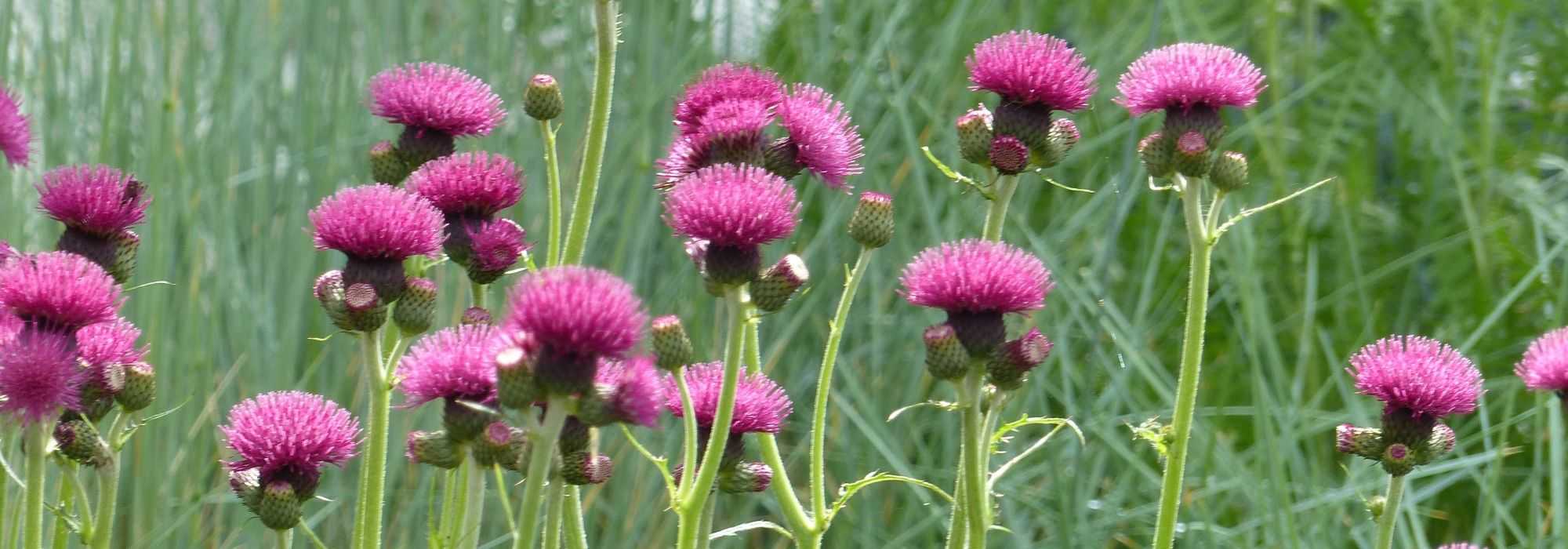
Cirse : planting, growing, care
Contents
Cirsium, in a nutshell
- Cirsiums are large perennials or biennials closely related to thistles, with simple, graphic, sometimes spectacular appearance, as with Cirsium japonicum ‘Rose Beauty’, very easy to grow.
- Flowers are borne as dishevelled heads or large white, pink to purple pom-poms, perched at the end of long, angular, translucent stems that bear large dark-green leaves at their base, more or less spiny.
- Plant in any ordinary soil, moist to dry depending on species, to accompany flowering of roses, in a meadow to enhance country feel or along a watercourse.
A word from our expert
River or brook thistle (Cirsium rivulare ‘Atropurpureum’) and field thistle Cirsium arvense, resembling thistles or knapweeds, are familiar sights in countryside. They combine charm of wild plants with colourful, sometimes spectacular flowering, as in aptly named Cirsium japonicum Rose Beauty, which bears large, splendid pompom inflorescences of vivid magenta-pink.
Cirsium, or cirses, are herbaceous plants, biennial or perennial, that gardeners rarely think to plant because of reputation of field thistle for being very invasive. The latter colonises fallow land, tracks and grazed meadows. The two species offered for gardens, rivulare and japonicum, do not present this problem and are perennial. Their angular, architectural stems rise to over 1 metre in height, bearing delicate, varied pompom heads in pink, purple or mauve that provide superb contrasts among culms of grasses or set against a smoke tree, for example. Their flowering lasts for several weeks between May and October.
Flowering stems of Cirsium are well suited to making fresh or dried bouquets. Picking them prevents production of an excessive quantity of seeds that hinders repeat flowering late in season. Even though species offered for garden (rivulare, japonicum) are not invasive, it is preferable to cut off dried inflorescences unless they attract local songbirds, in which case, leave birds to enjoy them.
These are plants very easy to grow but only in open ground, quite short-lived, that require dividing clump every 3 years to maintain culture.
Cirsium belong to family of Daisies but have a much lighter, more transparent silhouette that gives a country or contemporary touch depending on garden style. In any case, they are undemanding plants, rarely troubled by disease and that attract a host of pollinators.
Wild species Cirsium eriophorum, or wooly thistle, common notably in Aveyron and the Alps but present on continental areas from south of England to Spain, has likely caught your eye if you encountered it. It produces large involucres of spherical bracts that look as if woven by spiders, crowned with purplish heads, reaching up to 1.50 m in height in July–August.
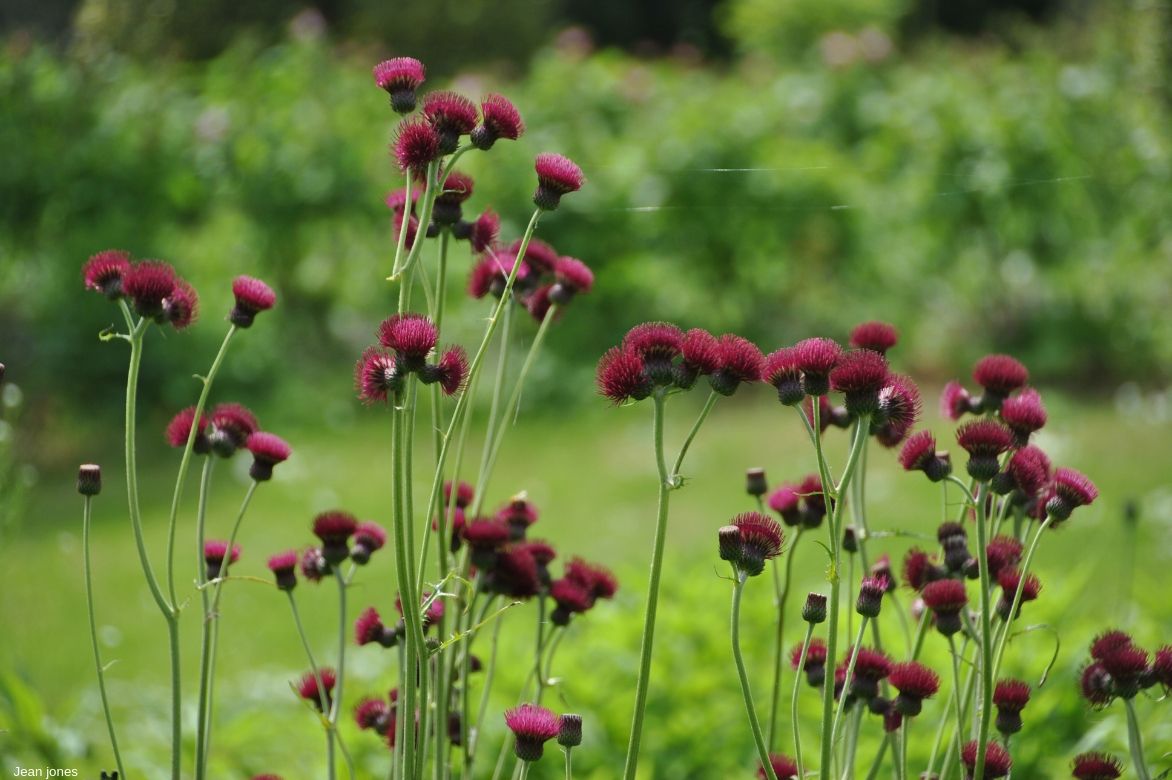
Superb Cirsium rivulare ‘Atropurpureum’
Description and botany
Botanical data
- Latin name Cirsium
- Family Asteraceae
- Common name Cirse, Sarette, Thistle
- Flowering between May and October
- Height between 0.60 and 1.50 m
- Sun exposure sun
- Soil type dry well-drained to compact moist depending on species, even calcareous
- Hardiness Excellent (-20 to -28 °C)
Genus Cirsium includes nearly 300 species and is commonly referred to as thistle. This generic term covers several spiny genera mostly belonging to the family Asteraceae (formerly Compositae) such as Carduus (thistle in the strict sense), Cynara (artichoke), Onopordum and Cirsium. The blue alpine thistle or sea holly (Eryngium alpinum) with its steel-blue tones belongs to the Apiaceae (umbellifers) like carrot, while the common teasel (Dipsacus fullonum), once used to card wool, is part of the Dipsacaceae. Thistles therefore form dense, compact heads that are either heads or umbels. They commonly grow on dry, poor ground while some Cirsium species such as rivulare prefer rich, fresh or even very wet soils.
Cirsium species are native to Eurasia and North America. These often large herbaceous plants are annual, biennial or perennial but short-lived. They grow very quickly and bear dense, nectar-rich inflorescences perched on long architectural stems. They produce numerous feathery seeds appreciated by birds such as goldfinches, contributing to plant dispersal that can be problematic in species like Cirsium arvense.
Distinction between genera Carduus and Cirsium is subtle. It is mainly based on the egrets of the fruits, also called pappus, which are composed of simple or denticulate hairs in true thistles and of feathery hairs in Cirsium.
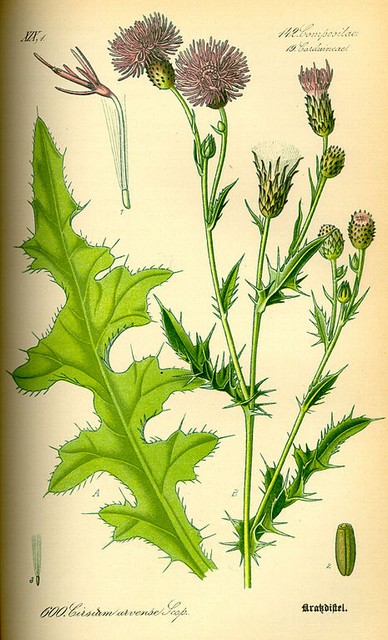
Cirsium arvense – botanical illustration
Stems of Cirsium, like those of other thistles, are often winged and leaves are alternate and thorny. Cultivated forms often have fewer spines, as in Cirsium japonicum Rose Beauty, which is almost inermous. Ornamental Cirsium commonly reach 90 cm to 1.20 m in height with a spread of 50–60 cm depending on soil richness and moisture, unlike true thistles. Large leaves of 20–40 cm long are glabrous or pubescent, often dark or light bluish-green, entire to deeply lobed into narrow segments, with spiny, dentate margins. Plants first form a rosette of large leaves that sends up a sparsely leaved, ramified flowering stem ending in hirsute heads, 3 to 5 cm in diameter. Aerial parts dry off completely at season end before reappearing the following spring from the rhizomatous stump. Cirsium rivulare is slightly less running than Cirsium japonicum, which can spread up to 60 cm rather than 50.
Inflorescence consists only of tubular flowers in pink, purple, bluish or white tones, with presence of scales or tufts of hair between florets. They are borne in an involucre of spiny bracts, particularly decorative in Cirsium eriophorum, the wooly cirsium, which forms a wooly sphere about 5 cm across crowned with magenta florets. The whiteness of the head is very luminous in Cirsium rivulare Frosted Magic.
Fruit is an achene topped by a white, feathery egret that forms a silky decorative mass under frost. Cirsium arvense provides a food source for birds such as goldfinch and skylark, whose populations are declining.
Cirsium japonicum has medicinal properties known since Antiquity: anti-inflammatory, haemostatic, diuretic, anti-infective, etc. Its roots are eaten raw or cooked in Chinese cuisine. Young cooked leaves of Cirsium and the involucre of Cirsium oleraceum, the farmers’ cirsium or cabbage thistle, are eaten notably in northern and eastern France. Plant is rich in phosphorus. Common or field thistle (Cirsium arvense) grows in lush meadows suitable for beef cattle. Wooly cirsium is favourable for dairy cattle and cheese production (sheep grazing is not recommended on such land because droppings raise already high pH). Excessive presence of these Cirsium indicates an excess of organic matter and nitrogen fertiliser from overgrazing, which has the effect of immobilising phosphorus in calcareous soil.
Word “cirses” comes from Latin cirsion, which denoted a species of thistle reputed to fight varicose veins, called kirsos in Greek.
Main varieties of Cirsium
Varieties to plant
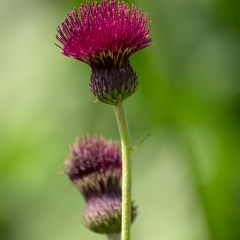
Cirsium rivulare Atropurpureum - Plume Thistle
- Flowering time July to September
- Height at maturity 1,20 m
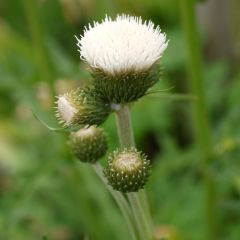
Cirsium rivulare Frosted Magic
- Flowering time August, September
- Height at maturity 1,20 m
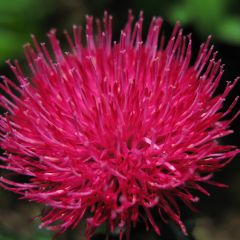
Cirsium japonicum Rose Beauty - Japanese Thistl
- Flowering time July to September
- Height at maturity 1 m
Varieties to sow
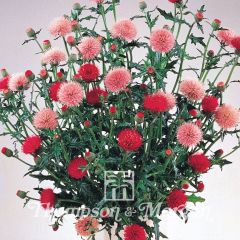
Cirsium japonicum Pink and Rose Beauty - Japanese Thistle
- Flowering time October, November
- Height at maturity 1,20 m
Discover other Cirsium
View all →Available in 0 sizes
Available in 2 sizes
Available in 1 sizes
Available in 1 sizes
Available in 1 sizes
Available in 1 sizes
Planting
Where to plant thistles?
Requirements of thistles vary depending on species. Riverbank thistle prefers rather heavy, rather damp to very damp, rich soil since it grows along watercourses whereas Japanese thistle requires ordinary to dry, well-drained soil, even poor.
In both cases, full sun is recommended or at least a minimum of 6 hours’ sun per day. Their lifespan is fairly short but sowing occurs frequently if you omit cutting faded inflorescences.
When to plant?
Planting can be done in spring or autumn for better establishment.
How to plant?
This plant is very easy to grow if you respect each species’ soil moisture needs.
For planting your thistles :
- Dip rootball into a bucket of water to thoroughly moisten it.
- Loosen soil over a 50 cm width to encourage extension of rootstocks.
- Add organic amendment for species rivulare, which likes rich soils, such as well‑rotted leaf compost. For species japonicum, add sand or gravel or plant in a rock garden to make soil sufficiently well‑drained.
- Dig a hole the size of the rootball to insert it, taking care not to bury the collar. Space young plants 30 to 40 cm apart if you wish to form a full border; otherwise insert some young plants within a meadow.
- Replace soil and firm lightly.
- Water and mulch, especially species rivulare, to maintain cool soil.
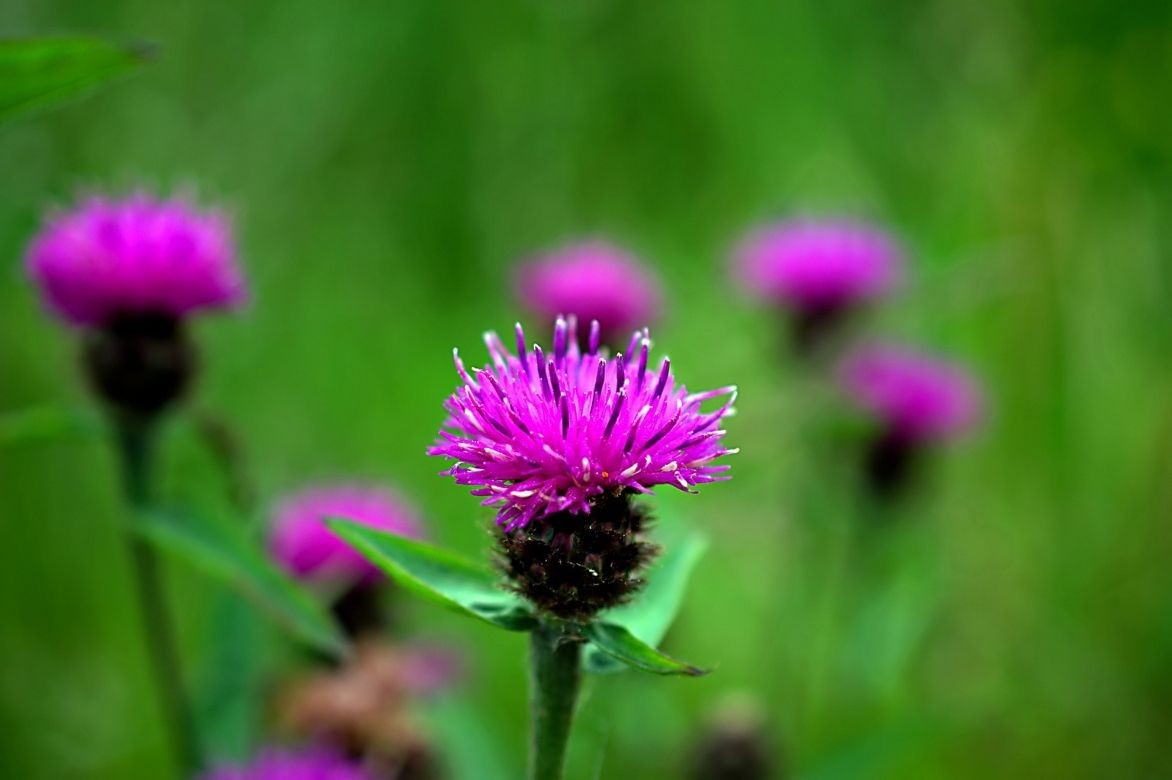
Read also
Echinops: planting, growing and careCare
- Simply cut faded flowers between June and July, then allow fruits to form in the hope of obtaining some viable seeds.
- Stake young plant discreetly if strong winds blow.
- Divide Cirse every three years to rejuvenate young plant, which tends to weaken and die.
- Cirse des rives is sometimes affected by powdery mildew or “white disease” during drought or poor air circulation. Water root area well and mulch it from mid-spring. Cut surrounding foliage if air circulation is poor.
Propagation: division, sowing
Simplest propagation method is to separate rootstocks in spring or September or to sow seeds between February and June.
Division
- With a well-sharpened spade, separate peripheral rosettes.
- Lift them and replant elsewhere in loosened soil.
Sowing
- Sow Cirse from February to June indoors or directly outdoors.
- Fill a tray with good-quality seed compost.
- Sow seeds as thinly as possible, mixing with sand for better distribution.
- Cover seeds with 2–3 mm of sieved compost or vermiculite.
- Firm down lightly and water copiously with a fine spray.
- Place tray in light, avoiding direct sun, at temperature of 15°C to 20°C.
Seed germination will take 21 to 40 days.
- As soon as young plants reach height of 5 cm, pot them into buckets.
- Take care to harden off young plants over 15 days before planting permanently in garden in a very sunny spot in late spring or early autumn. Wait until end of May for temperature to be warm enough.
Early-season sowings will flower in first year. For later sowings, wait until following year to see flowers.
Uses and companion planting
You can flower a stream or pond bank, in cool soil with Cirsium rivulare which pairs with the erect, slender magenta spikes of loosestrife, with the marsh sage whose loose, slightly untidy clumps bear delicate sky-blue inflorescences, with airy meadow-rue in white, lemon-yellow or mauve, or with the small pale-pink star-shaped flowers of Lychnis flos-cuculi.

A natural planting idea: Cirsium rivulare ‘Atropurpureum’, Selinum wallichianum, Stipa tenuifolia and Sisyrinchium striatum, Geranium ‘Nimbus’, Allium christophii
Upright and wild thistles both add, without demanding care, a bit of spice to an otherwise dull meadow or natural garden. Their bold, sculptural clumps create rhythm and surprise with blue-green foliage topped by large purple or white heads that sway gently in a summer breeze.
Japanese thistle, fond of dry soil, pairs beautifully with the silvery foliage of lavender, cistus or santolina.
The Japanese thistle cultivar ‘Rose Beauty’, with very large heads, holds its own alongside Echinaceas and Rudbeckias, playing with colour and contrasting with more airy plants such as Gauras and bottle-brush grasses.
→ Discover other ideas for pairing thistles in our advice sheet!
To go further
Discover our range of Cirsium.
Frequently asked questions
-
How to get rid of creeping thistle?
Cutting the plant often causes rapid regrowth of new shoots per clump because of its very running rootstocks. Ploughing also helps divide the rootstocks. Therefore, the best means of control is to cut the plant at bud stage, as this is when reserves contained in the rootstocks are at their lowest. Removing the flower heads also prevents seeds from dispersing, since a single plant produces several thousand seeds. Seeds can remain viable for 20 years!
- Subscribe!
- Contents
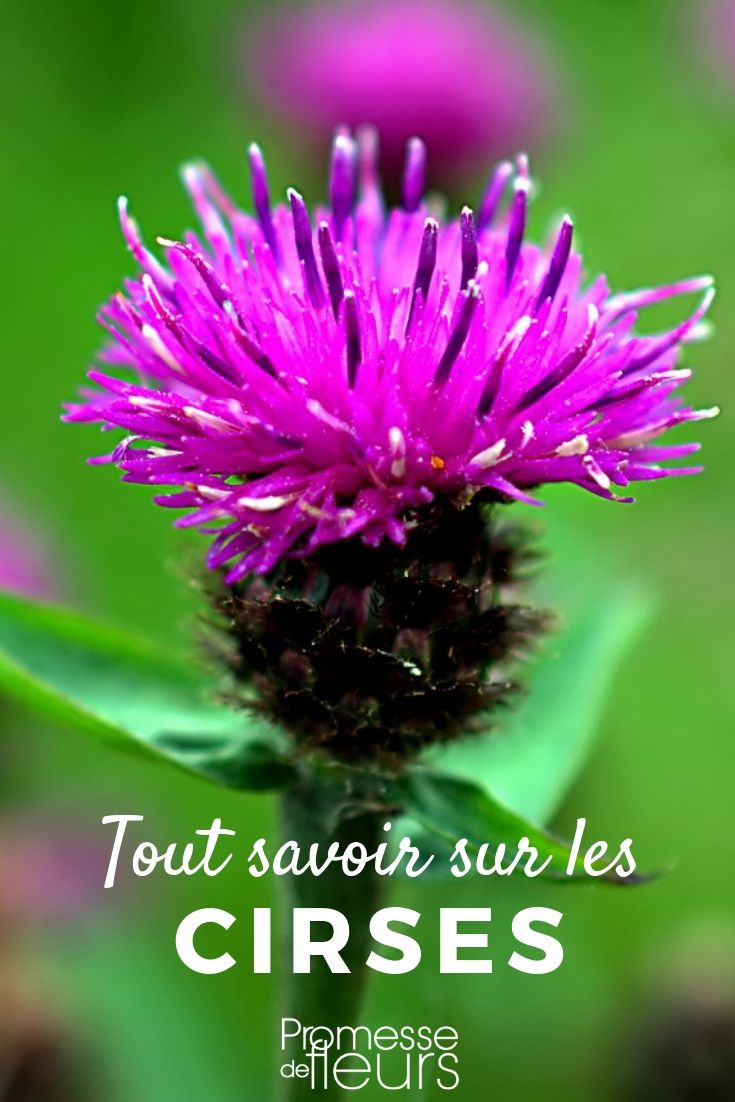































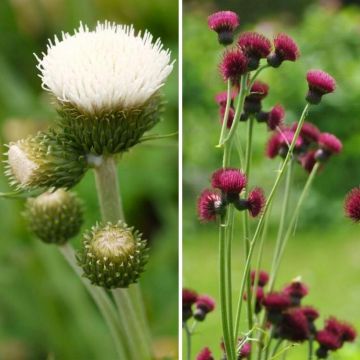



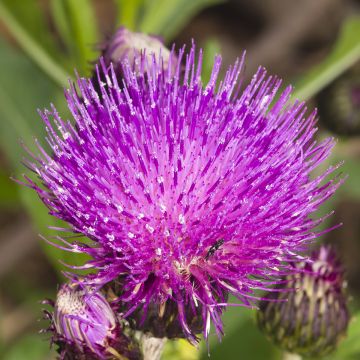

Comments